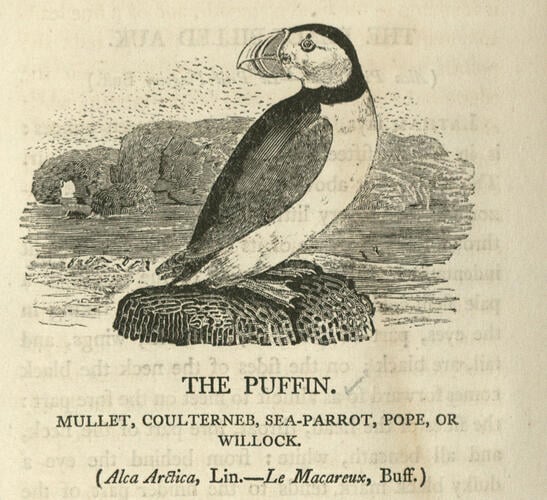-
1 of 253523 objects
A History of British birds ; v. II containing the history and description of water birds / figures engraved on wood by T Bewick. 1805
27.0 x 17.4 x 4.1 cm (book measurement (conservation)) | RCIN 1055618
-
Thomas Bewick was a Newcastle-based publisher and natural history author. Born at Cherryburn in Northumberland, Bewick was apprenticed to the engraver Ralph Beilby, from whom he learned how to engrave on wood and metal. Beilby preferred the latter, leaving his apprentice to learn the former. The young Bewick showed an immediate aptitude, quickly developing his own techniques that earned him a medal from the Royal Society of Arts in 1775 for his designs. The innovations popularised by Bewick saw carvings made against the grain of the wood with tools normally reserved for metal engraving. This allowed for much greater detail and subtler shading in the resulting print compared to a traditional woodcut.
Becoming a partner in 1776, the business became recognised for the fine quality of its engravings. In 1790, Bewick and Beilby published their History of Quadrupeds (referred to by Bewick simply as 'Quads'), a natural history of four-legged animals (see RCIN 1055619).The book was an instant success and soon Bewick was inundated with letters from naturalists and interested amateurs. Among the keen patrons were solicitor and naturalist George Allan and Thomas Pennant, who saw Bewick as a prospective successor and encouraged him to write about species he had omitted from his British Zoology. In the autumn of 1790, Beilby received a letter from Sir Joseph Banks via the local naturalist Marmaduke Tunstall, urging the pair to begin a history of birds.
Bewick had mentioned a possible book on birds to Allan and the Durham historian William Hutchinson in 1786, but the idea had depended on if Quadrupeds sold well. Given Banks’s support, Bewick and Beilby soon began work on the new project. Bewick wrote that he had held a lifelong passion for birdlife and ‘busied myself very much in reading various descriptions or accounts of them’, reading a range of natural histories of birds, some borrowed from Allan’s library at Blackwell Grange near Darlington.After Marmaduke Tunstall’s sudden death in late 1790, the following summer, Bewick was invited to his home at Wycliffe to make drawings from his large collection of natural history specimens. He also took great interest in Tunstall’s annotations to the books in his library and his extensive ornithological notes, declaring that they would be of great use for the prospective work. However, such was the wealth of information that Bewick soon declared that the project ought to be restricted to British birds only, with one volume focusing on land birds and a second on water birds.
The visit to Wycliffe was productive but Bewick quickly became frustrated with Tunstall’s museum, complaining of a ‘very great difference between preserved Specimens & those from nature, no regard having been paid at that time to place former in their proper attitudes nor to place the different series of feathers, so as to fall properly upon each other. This has always given me a great deal of trouble to get at the markings of the dishevelled plumage & when done with every pains, I never felt satisfied with them.’
As a solution, Bewick instead sought to illustrate as many birds as possible from life, from his own excursions to the hills of Northumberland, coastal visits or his daily walks through Newcastle. He also spoke to correspondents of his search for unusual and non-local species and they soon responded by sending him their own drawings, descriptions and freshly shot specimens.Despite a rift between Bewick and Beilby which led to the dissolution of the partnership shortly after the publication of Land Birds in 1797 (see RCIN 1055617). The book proved an instant success and saw the cementing of Bewick’s reputation as the leading naturalist of the day. He soon received many more letters from his admirers and local gentry, urging him to capitalise on the book’s success and to issue the volume on water birds without delay.
Such a quantity of letters caused problems for Bewick. Determined to complete his study of waterfowl, he was constantly distracted by correspondents sending him birds to identify as well as gifts of shot specimens to draw. Bewick also struggled with his descriptions for the new book. Writing without Beilby’s notes, he was unable to keep his accounts concise and turned to a friend, Henry Cotes, to edit the text. Other friends came to his assistance, sending him specimens of rare and unusual waders and sea birds to be included in the volume.
When preparing the work for print, Bewick ensured that he added citations acknowledging the sources of his specimens and his authorities. Water Birds was ready for publication in July 1803 but further demands on his printers meant that it took almost a year for the work to be completed.Water Birds proved to be Bewick’s crowning achievement. Like Land Birds, the book offered an inexpensive, informative guide with extremely detailed illustrations that allowed adults and children alike to identify different bird species. It became a common schoolbook for a generation of children, with writers such as Alfred, Lord Tennyson, Charles Kingsley (of The Water Babies fame), Charlotte Brontë and Beatrix Potter all declaring its influence over their views of the natural world.
Primary Source: Jenny Uglow, Nature's Engraver: A Life of Thomas Bewick (London, 2007)Provenance
Purchased as a set with A History of British Birds : Land Birds (Imperial 8vo, RCIN 1055617) and A History of Quadrupeds (5th edition, Imperial 8vo, RCIN 1055619) by George IV when Prince of Wales from Thomas Payne, 27 June 1808, for £7.17.6 (RA GEO/MAIN/28512)
-
Creator(s)
(publisher)(bookseller)(bookseller)Acquirer(s)
-
Measurements
27.0 x 17.4 x 4.1 cm (book measurement (conservation))
Alternative title(s)
A History of British birds. The figures engraved on wood by T. Bewick. Vol. II. containing the history and description of water birds.
